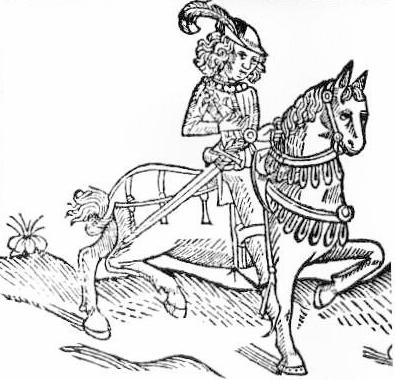
Chaucer's Literary Life and the Fortunes of the Canterbury Tales
First, a cautionary note: "periods" in authors' lives are questionable critical shorthand for a more nuanced and less certain view of the author's life and writing. Imagine a similar "periodization" of your own life and what errors could arise from too simple an application of it to interpretations of your own papers if most other evidence of their order of composition were absent. The estimated composition dates of some works are still debated, and "early" works are subject to the chance that Chaucer returned to them later in his career. The "Second Nun's Tale," for instance, has been thought to be an "Italian Period" work of honest piety which an older Chaucer later assigned to the pious nun who accompanies Prioress on the pilgrimage and might be said to be competing with her superior in a pious duel of saint's lives (RC 942 and see the note to lines 25-26 on 943!). As an independent work attributed directly to Chaucer-the-poet, its tale of St. Cecelia's chastity and martyrdom would strike us much differently if we thought it were in the voice of a passionately religious Geoffrey Chaucer than it does when it seems to be told by a nun after the Nun's Priest's riotous beast fable and before the Canon's Yeoman's "thief's confession" (Ellesmere order), or between the Franklin's and Clerk's tales of troubled mortal marriages. Setting any tale within the pilgrimage frame creates distance between its historical author's beliefs (Chaucer-the-poet) and its newly intended effects upon its readers. From his youth, Chaucer probably knew French, Italian and English, but his choice of models to emulate as his artistry grew might well have followed these stages.
"The French Period" (? to around 1372)--mainly influenced by Guillaume de Machaut, Froissart, Jean de Meun, Eustache Deschampes, etc.
---c. 1360s?, The Romaunt of the Rose, a translation of de Meun's Roman de la rose (itself a 1280 continuation of the work left incomplete at the death of Guillaume de Lorris c. 1237), the first 4000 lines of de Lorris's allegory of Love, stopping before de Meun's satire on women and love.
---probably 1369, The Book of the Duchess
---1372-80 Short poems, esp. balades in the French courtly style like "Gentillesse" and Trouthe," and some Canterbury Tales (2Nun, Monk).
"The Italian Period" (1372-85)--additionally influenced by Boccaccio, Dante, Petrarca, etc.
---c.1379 The Hous of Fame
---1373-85? Boece, a translation of Boethius' De consolatione philosophiae (The Consolation of Philosophy)
---1380-82 The Parlement of Foules [2nd or 1st Italian Journey--first clearly indicated by surviving documents]
---1382-85 Troilus and Criseyde, transforming Boccaccio's Il Filostrato (5704 lines become 8239 lines) with additional matter from Benoit de Sainte-Maure's Roman de Troie. CT: First version of Knight's Tale (possibly related to "Anelida and Arcite," RC pp. 375-81), later Balades.
"The English Period" (1380-1400)--drawing upon various forms found both in England and on the continent (saint's life, fabliau, romance, beast fable, sermon) but with more assurance in varying or combining sources, fusing genres, bending genres (WoBPro, CYT); perhaps influenced by English mystics and John Gower, etc.
---1388-1392: CT: "General Prologue," earlier tales.
---1392-5: CT: Most of tales, including "Marriage Group," with some endlinks and prologues.
---1396-1400: CT: NPT, CYT, Parson's T, the "Retraccioun," and the "Envoys" to Scogan and Bukton. Perhaps some revisions in the Troilus and other earlier poems.
1400-1478: Chaucer's works circulated in manuscript form, acquiring numerous additional lines, and being rearranged to suit the tastes of scribes and their patrons. Eighty-two manuscripts survive, representing four basic manuscript families based on the order of their tales and the errors that were introduced in copying (see RC: 1121). To survey the surviving tale orders, click
1478: William Caxton publishes the first printed edition of Chaucer's Canterbury Tales from a manuscript of the "b" text family (see RC: 1121), unfortunately a copy missing lines and containing spurious lines in such numbers that even casual readers familiar with the tales were dissatisfied.
1483: William Caxton publishes a "corrected" edition of Canterbury Tales, based on a better manuscript, but still containing many misreadings and in a tale order corresponding to none of the surviving MS families. It also was given 26 woodcut illustrations of the pilgrims, the first attempt to represent them visually since the Ellesmere MS illuminations. This edition was reprinted many times by Wynkyn de Worde and Richard Pynson, the pressmen who succeeded Caxton in his ownership of the first printing press in England. Below, you can see Caxton's woodcut purporting to illustrate the pilgrim Squire. He got the hair right, but compare the Squire's "array" or clothing with the General Prologue portrait (ll. 79-100)--what might account for the discrepancy?

Between 1500 and the current era: twelve major editors have had a hand in reshaping the canon of Canterbury Tales: William Thynne (?1550), John Stow (1561), Thomas Speght (1598--Goucher owns a copy of this edition), John Urry (1721, posthumously published by Bernard Lintot), Thomas Tyrwhitt (1775), Thomas Wright (1847/51), Frederick James Furnivall (numerous parallel text MS transcriptions for the Early English Text Society [EETS], 1868-1902), Walter Skeat (1894-5 for Clarendon Press, whose second edition [1900] is still in print), F.N. Robinson (1933, the first published by Houghton Mifflin [RC] and the first edited by an American), John M. Manly and Edith Rickert (1940), and Larry Benson (1987--the one you are using, based on Robinson's second edition, and notable for Benson's decision to assign the explicating notes on individual works to eleven "advisory text editors" and twenty-two "Contributors" (see the page opposite the title page and look for their names in the back. For more on their contributions, see Paul Ruggiers ed., Editing Chaucer: The Great Tradition (Norman, OK.: Pilgrim, 1984).